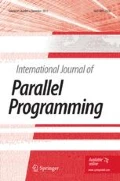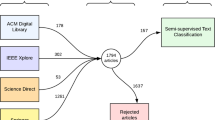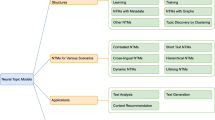Abstract
Text clustering plays an important role in data mining and machine learning. After years of development, clustering technology has produced a series of theories and methods. However, in the text clustering of Chinese news, the mainstream LDA method suffers a high time complex. In order to improve the speed, this paper puts forward a new method in which neural network language model is first applied to text clustering. Text clustering is first converted to its dual problem called word clustering. With neural network language model, we can get word vector which can be used in the fuzzy k-means of the Chinese news keyword set. Based on the keyword clustering result, we can get text clustering result of Chinese news by a single transition. Experiments have show this method’s running speed is five times faster than LDA. This method has been successfully used in the Sohu news recommendation system currently.

Similar content being viewed by others
References
Blei, D.M., Ng, A.Y., Jordan, M.I.: Latent dirichlet allocation. J. Mach. Learn. Res. 3, 993–1022 (2003)
Aggarwal, C.C., Zhai, C.X.: A survey of text clustering algorithms. Mining text data. Springer, US (2012)
Ko, Y.: A study of term weighting schemes using class information for text classification. In: Proceedings of the 35th international ACM SIGIR conference on research and development in information retrieval. ACM (2012)
Bengio, Y., et al.: Neural probabilistic language models. Innovations in machine learning. Springer, Berlin (2006)
Berkhin, P.: A survey of clustering data mining techniques. Grouping multidimensional data. Springer, Berlin (2006)
Rajaraman, A., Ullman, J.D.: Data mining. Mining of massive datasets. Cambridge University Press, Cambridge (2012)
Casella, G., George, E.I.: Explaining the Gibbs sampler. Am. Stat. 46.3, 167–174 (1992)
Zeng, H.-J., et al.: CBC: clustering based text classification requiring minimal labeled data. Data mining, 2003. ICDM 2003. In: 3rd IEEE international conference on IEEE (2003)
Decherchi, S., et al.: A text clustering framework for information retrieval. J. Inf. Assur. Sec. 4, 174–182 (2009)
Kalogeratos, A., Likas, A.: Text document clustering using global term context vectors. Knowl. Inf. Syst. 31.3, 455–474 (2012)
Kang, S.-S.: Keyword-based document clustering. In: Proceedings of the 6th international workshop on information retrieval with Asian languages-Volume 11. Association for computational linguistics (2003)
Cheng, H.-C., Chiun-Chieh, H.S.U.: Using topic keyword clusters for automatic document clustering. IEICE Trans. Inf. Syst. 88.8, 1852–1860 (2005)
Jing, L., Ng, M.K., Huang, J.Z.: An entropy weighting k-means algorithm for subspace clustering of high-dimensional sparse data. Knowl. Data Eng. IEEE Trans. 19.8, 1026–1041 (2007)
Berry, M.W., Castellanos, M. (eds.): Survey of text mining. Springer, New York (2004)
Hotho, A., Nurnberger, A., Paaß G.: A brief survey of text mining. Ldv Forum. 20, 19–62 (2005)
Horng, Y.-J.: A new method for fuzzy information retrieval based on fuzzy hierarchical clustering and fuzzy inference techniques. Fuzzy Syst. IEEE Trans. 13.2, 216–228 (2005)
Tjhi, W.-C., Chen, L.: A heuristic-based fuzzy co-clustering algorithm for categorization of high-dimensional data. Fuzzy Sets Syst. 159.4, 371–389 (2008)
Heinrich, G.: Parameter estimation for text analysis. Technical report (2005)
Powers, D.M.W.: Evaluation: from precision, recall and F-measure to ROC, informedness, markedness and correlation. J. Mach. Learn. Technol. 2.1, 37–63 (2011)
Acknowledgments
We would like to thank ICT big data system team members and SOHU mobile research development team members, especially Jian Lin and Wei Liu to help give good suggestions in this paper. This research is supported partly by the Hi-Tech Research and Development (863) Program of China (Grant No. 2013AA01A213).
Author information
Authors and Affiliations
Corresponding author
Rights and permissions
About this article
Cite this article
Fan, Z., Chen, S., Zha, L. et al. A Text Clustering Approach of Chinese News Based on Neural Network Language Model. Int J Parallel Prog 44, 198–206 (2016). https://doi.org/10.1007/s10766-014-0329-2
Received:
Accepted:
Published:
Issue Date:
DOI: https://doi.org/10.1007/s10766-014-0329-2




